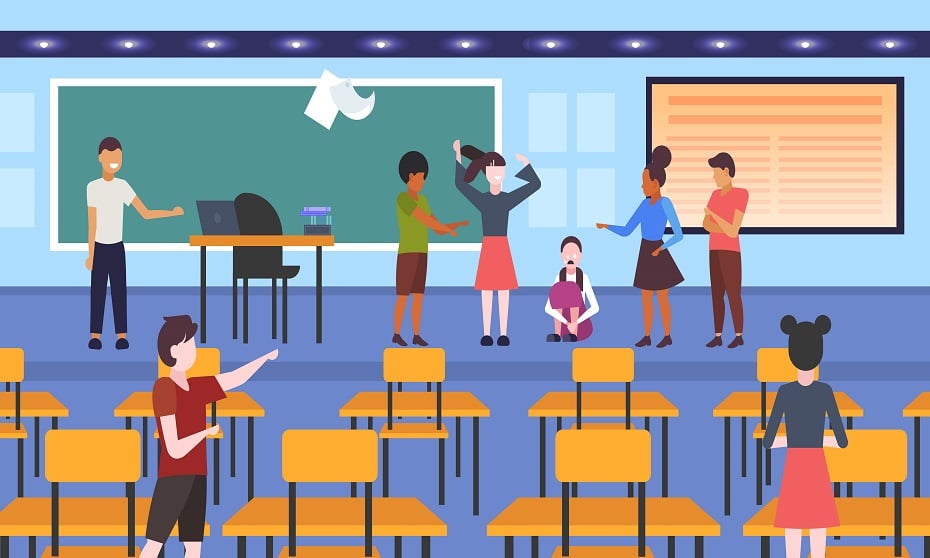Teachers bitten, kicked, threatened and harassed in the classroom

The student kicked me in the head. No first aid was offered, no medical support was offered, no break was offered, no support of any kind was offered. I am still suffering from longterm brain damage and cannot work.”
“A student threw a chair at me which hit me on the side of my head. While I was wearing a PPE jacket and arm guards, I was not provided anything to protect my head.”
“The most terrifying part was being chased down the hall and feeling conflicted, as my job was to ensure the safety of others, while I was simultaneously terrified. I immediately broke down when I reached the safety of a room and was able to lock the student out.”
These are just some of the experiences teachers are facing in classrooms across Canada. These particular quotes came from a report titled Facing the Facts: The Escalating Crisis of Violence Against Elementary School Educators in Ontario, released by the University of Ottawa in September, which was based on findings from a survey of 1,688 educators across the province. “Educators” included contract and occasional teachers, education support personnel, professional support personnel, early childhood educators and other educational professionals.
The study found a nearly seven-fold increase in violence against educators over the past 12 years. While seven per cent of Ontario educators reported experiencing violence at some point in their careers in a 2005 study, the University of Ottawa study found that that rate is now 54 per cent in a single year. Overwhelmingly, the violence is perpetrated by students.
The phenomenon is not just a problem in Ontario but right across the country. According to Shelley Morse, president of the Canadian Teachers’ Federation, which represents 273,000 teachers across Canada, every province and territory is reporting that violence is increasing in the school system. Research from the organization found that between 40 per cent and 90 per cent of educators (depending on jurisdiction) said they have experienced violence at some point in their careers.
“This is just kind of routine. It’s routine for kids, it’s routine for educators… I honestly think the violence we are experiencing in schools, it’s like we’ve got a recipe for it — it’s almost inevitable,” says Chris Bruckert, one of the researchers on the University of Ottawa study. “If you put it all into some sort of machine, it would spit out violence.”
Some of these elements include an increase in class sizes, fewer educational assistants for students with special needs, a rise in mental health issues among students — according to Children’s Mental Health Ontario, one in five students faces mental health challenges — and an overall lack of funding for resources. Students’ needs are often being unmet and, as a result, they become frustrated and lash out in class.
Morse points to a societal increase in incivility and the difficulties of disciplining students as key contributors to violence and harassment toward teachers.
“It’s a very real problem in our school system and I call it the ‘silent crisis’ because nobody wants to talk about it,” she says.
Morse herself has been kicked, punched, spat on and had chairs thrown at her when she was teaching. Teachers across Canada are experiencing these types of violent acts along with biting, hair pulling, grabbing, headbutting, tripping, being attacked with classroom items (scissors, pencils, razors, glass shards, sharp utensils), being sexually assaulted (one teacher spoke of boys grabbing her breasts as part of a game) and receiving threats to exercise physical force.
“A teacher recently called in because a middle school student said to them that their father was a police officer and they were going to get a gun and shoot the teacher,” says Gail Bannister-Clarke, president of the Peel Elementary Teachers’ Local in Mississauga, Ont., which has more than 7,000 members. “That’s a threat. The teacher took that seriously and felt threatened.”
According to the University of Ottawa study, 60 per cent of educators reported being on the receiving end of attempted physical force and 49 per cent experienced one or more threats.
Sometimes, the violence is so bad (either toward the teacher, educational assistants or other students) that the classroom has to be evacuated due to safety concerns. When Bannister-Clarke was teaching, she had a violent student in her class and she had to evacuate the room once.
Harassment pervasive
Teachers are not just experiencing violence but “unacceptably high” levels of harassment as well, according to the University of Ottawa study. Nearly three-quarters (72 per cent) of survey respondents reported experiencing explicit verbal insults (including graphic swearing), putdowns and obscene gestures from a student in the 2017-18 school year, while 41 per cent experienced this sort of behaviour from a parent.
Teachers are also victims of inappropriate jokes and innuendos, bullying, prank phone calls, intimidation and pressure tactics, taunts, homophobic comments and racial slurs.
“A lot of what we’re seeing is disrespect,” says Bruckert. “[For example], swearing can sound somewhat banal, but if this is a recurring occurrence, it can be quite traumatic. I am not a prude, but I was shocked at the language, absolutely shocked… The amount of racism, anti-Semitism, Islamophobia — that really did surprise me because we’re talking elementary school.”
One issue that teachers have is that they are constantly recognizable in the community, so verbal harassment follows them everywhere, from the grocery store to the local swimming pool, notes Paul Wozney, president of the Nova Scotia Teachers’ Union, which has 9,100 members.
“When you go to the hockey rink, you don’t stop being Mrs. So-and-so. When you go to the church, the mosque, the synagogue, you’re still Mrs. So-and-so,” he says. “You never get to take your teacher hat off.”
Social media adds another layer to the harassment that teachers face — it doesn’t necessarily stop when they get home.
“I suppose when you know who’s threatening to slit your throat, it’s disturbing, but you know who said it, so you have some way to address it. It’s another thing altogether when people make an account that’s nameless and faceless and say those things to you,” Wozney says. “It starts to fold into cybercrime at a certain point.”
Violence can lead to a variety of injuries such as broken bones, cuts and scrapes, concussions, permanent brain damage, mobility challenges, chronic pain and migraines. However, it’s often the mental anguish that has the most lasting effect. According to the University of Ottawa report, high levels of either violence or harassment are associated with diminished physical and mental health and lower job performance.
“They are feeling fearful at work. Imagine going to work and you’re scared every day. That’s incredibly destabilizing… It’s amazing the longterm impact. Violence reverberates though educators’ lives,” says Bruckert.
Her study estimates that lost-time due to harassment and violence against educators in Ontario exceeds $3 million annually. Educators report taking an average of 6.84 days off work following their worst case of harassment and an average of 5.18 days off following their worst case of physical violence.
Peel region — which includes the cities of Mississauga, Brampton and Caledon in Southern Ontario — is seeing an increase in long-term disability claims, with 51 per cent of the claims attributable to “mental nervousness,” which Bannister-Clarke says is likely related to an increase in violence and harassment. The majority of workers taking the leave in Peel region are in kindergarten or primary classrooms and split grades. The teachers going on leave are quite young — 29 per cent are between the ages of 35 and 39, while 15 per cent are between the ages of 30 and 34.
Morse is also seeing teachers displaying symptoms of post-traumatic stress disorder and anxiety disorder.
Reporting lacking
Just 53 per cent of all violent incidents are reported by Ontario educators, according to the University of Ottawa report. More than one in five respondents said that talking to their administrator was not helpful.
The educators described a range of work-related reprisals for reporting violence or harassment, including being given undesirable teaching assignments, the denial of professional development opportunities, having working conditions eroded and being pushed or transferred out of the school, the study found.
“The mindset has to change,” says Bruckert. “Educators have to be encouraged to fill out the reports by their administrators, not just by their union and occupational health and safety, but by their bosses and then be supported when they do — not face reprisals, not be blamed, not be questioned.”
At the Peel region, there is a process in place for reporting violence that is inflicted by students, but it needs to meet such stringent criteria — seven specific items — that many instances just don’t make the cut.
“You may be getting bitten every day, but that’s not seen as violence that needs to be reported,” says Bannister-Clarke. “[We] need to broaden that scope and understand that any violence is violence… There needs to be mechanisms to report it as long as you feel you are getting injured, and administrators need to be able to respond.”
Addressing the problem
All sources interviewed for this article pointed first and foremost to the need for more student supports and additional resources to reduce violence in the classroom. They said the needs of students must be identified earlier, special rooms must be available for students to decompress and the number of teaching assistants, mental health specialists, guidance councillors and social workers must increase.
Participants in the University of Ottawa study also noted the need for clear policies and consistently applied consequences for violent, harassing and inappropriate behaviour.
“If administrators were supported in their role by their boards as someone who can deliver consequences to students who are acting disrespectfully, that would change things a lot,” Morse says.
Another recommendation in the study was appropriate professional development for educators. More than two-thirds (68 per cent) of educators said they would welcome social-emotional learning programs and 55 per cent said they would welcome non-physical intervention programs. Only 36 per cent of educators said they were confident in their ability to deal with an incident of physical violence. Many teachers across Canada already receive non-violent crisis invention training.
But not everyone is convinced that more training is necessary. Morse says it’s a “band-aid solution” and Bruckert says it puts the blame on educators, making it seem like these issues would not be happening if they only had more training.
“It doesn’t matter how well trained you are. If you have seven individual education plans and two high-needs kids and you have 24 kids in your class and three of them are reading below grade level and you have to prepare for standardized testing, it doesn’t matter how much training you’ve had, you cannot do it all, it’s not possible,” Bruckert says.
Bannister-Clarke notes that both teachers and administrators need training on the basic requirements of occupational health and safety legislation, including how to conduct risk assessments and summon immediate assistance.
An identification system for students with a history of violence could also be helpful when they are transferred throughout a school board or district, Bannister-Clarke says.
“When they are transferred, the teacher may not have the history. That happens often. That’s basic, but those things are overlooked,” she says, adding that an identification system would be especially helpful to supply teachers.
Personal protective equipment (PPE) is not something you would expect to find in a classroom, but it’s there in many forms. Whether it be Kevlar gloves or protective sleeves, padded jackets, leg guards or helmets and reinforced caps, educators across the country are supplied with protective apparel. It’s more commonly the educational assistants and those working with students with special needs who are wearing the PPE.
“When you’ve gone home four times in a year because you’ve lost a quarter-pound of flesh because a kid’s bitten a chunk out of your arm and you have infections and you’ve missed three months of work, it should stand to reason that you should be instantly supplied with protective equipment from preventing that from happening again,” says Wozney, explaining that PPE is not often made available to the educators who need it.
Time to start talking
It’s important for safety professionals to get the conversation going about violence in the classroom and increase awareness, says Bruckert. Violence and harassment need to be clearly defined and educators need to understand that this is not something they should simply tolerate.
“Educators themselves are starting to see it as part of the job. They are being told sometimes, ‘It’s part of your job. You know what you signed up for.’ It’s on every professional involved in this to break that narrative and make it clear this is not part of the job and this is what violence looks like,” she says.
Safety professionals are very familiar with the right to refuse unsafe work, but it’s difficult for teachers to exercise this right.
“It’s so hard because it competes with their duty of care,” says Bruckert. “They are responsible for the children, so they would have to refuse to work before the day starts to ensure provisions are made for the supervision and instruction of their students. It’s their right, but then the responsibility for the children under the Education Act appears to trump their ability to exercise that right.”
Although it is challenging, there have been some successes with teachers exercising this right in Peel region, says Bannister-Clarke.
“We have had it where teaches are working with our vice-presidents in the office and our health and safety teacher advisor and they will say what the ongoing issues have been. We start by ensuring that there is a safety plan in place. Sometimes, there isn’t anything at all or we haven’t reassessed the risk of violence following a violent incident… But it doesn’t prevent behaviour from occurring,” Bannister-Clarke says. “So, then teachers have said, ‘This is unsafe conditions,’ and they have refused work.”
There are more instances of educational assistants refusing unsafe work because they don’t have primary responsibility for all the children in a classroom.
Even with the right to refuse unsafe work, it is very hard for teachers to personally do this because they take their responsibility to protect the safety and well-being of their students very seriously, says Bruckert, adding that it’s precisely this notion that increases their vulnerability to violence.
“In order to protect a child from another child who is throwing something, they put their bodies in the way in order to prevent child B from getting hurt. They are trying to protect the child, but they take the brunt of whatever projectile is in the air, or of a fist or whatever — and there are many, many stories of that,” she says. “Teachers care deeply."
This article originally appeared in the March/April 2020 issue of COS.
WHAT CONSTITUTES VIOLENCE AND HARASSMENT?
Examples of workplace violence:
• exercising physical force (e.g., hitting, kicking, biting, hair pulling, sexual assault)
• an attempt to exercise physical force
• any threat to exercise physical force (e.g., verbal threats, shaking a fist in someone’s face, wielding a weapon).
Examples of workplace harassment:
• verbal taunts and put-downs
• remarks, jokes or innuendos that demean, ridicule or offend
• offensive phone calls, texts, social media posts or emails
• leering or inappropriate staring
• unnecessary physical contact of a sexual nature
• bullying
• false accusations or spreading rumours.
Source: Facing the Facts: The Escalating Crisis of Violence Against Elementary School Educators in Ontario, University of Ottawa
BY THE NUMBERS
- 11,000 Number of violent incidents against teachers per year in Nova Scotia. That works out to more than one incident per year per teacher
- 2,471 Number of cases of violence reported in 2016-17 by educational assistants in New Brunswick
- 70% Percentage of elementary teachers in Ontario who say they have personally experienced violence or have witnessed violence in schools
- 311 Number of reported incidents of student violence against Edmonton teachers in the 2016-17 school year
- 90% Percentage of teachers in British Columbia who report having been the target of violence or bullying.
Sources: Nova Scotia Teachers Union, CUPE 2745, Elementary Teachers’ Federation of Ontario, Global News, BC Teachers’ Federation





